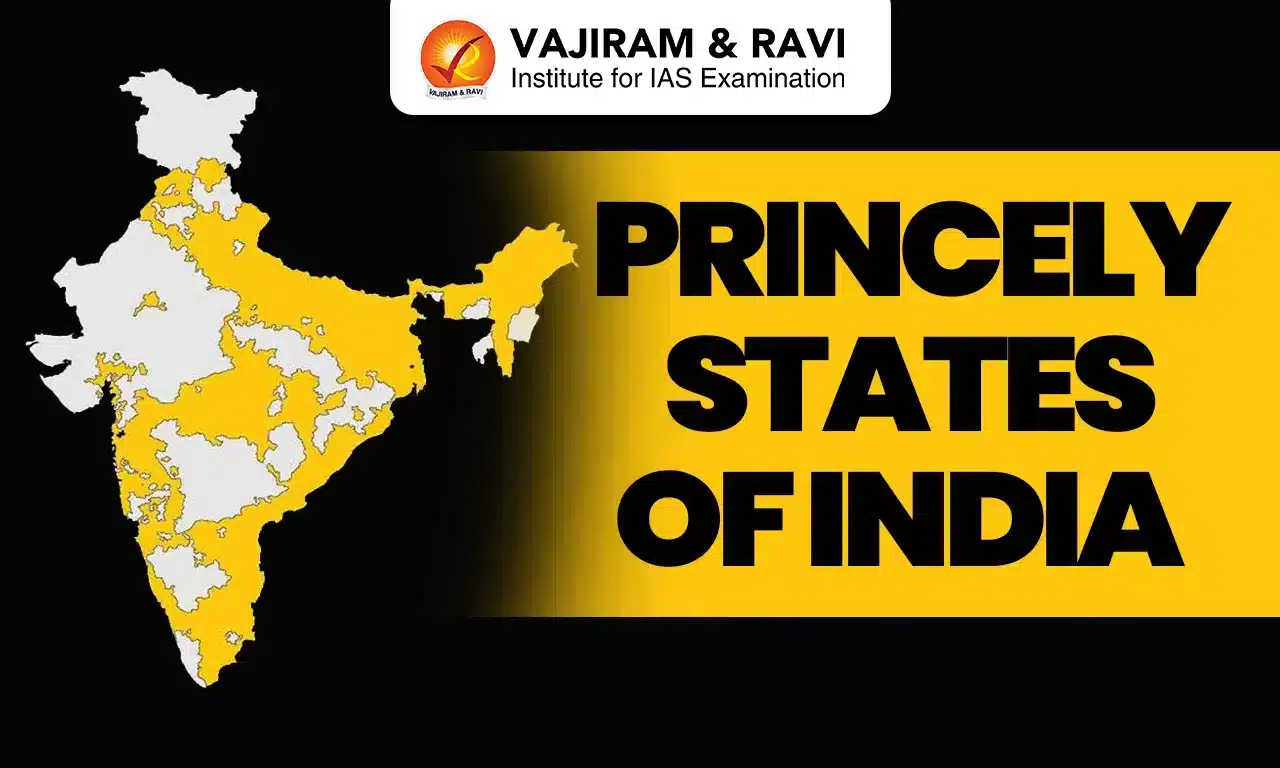Princely States of India: The era of British colonial rule in India witnessed a unique and diverse landscape of governance, marked by the presence of princely states. They were a diverse collection of states that varied in size, composition, and income. These states, governed by local monarchs, held varying degrees of autonomy under the suzerainty of the British Crown.
Over the years, with British policies, the structure of princely states changed to a great extent, with the impact of strategies such as Subsidiary Alliance, Subordinate Isolation, and the Doctrine of Lapse. The Indian freedom struggle also gradually impacted these princely states, as the call for democracy, civil liberties, and independence resonated with their subjects.
Genesis of New Princely Order
The grand structure of the princely order resulted from the various patterns of the British conquest of India and the methods used to create an empire.
- The princes ruled about two-fifths of the Indian sub-continent, having one-third of the population of the British Empire.
- Some of these states, such as Mysore, Hyderabad, and Kashmir, were the size of many European countries, while others had very small feudal estates.
- All of these states shared the recognition of the British Crown's supremacy.
- The British shielded the Princes from any threat to their autocratic power, whether internal or external.
- Most of the Princely states were administered as absolute autocracies. All of these 'absolute' rulers walked with all their grandeur and dignity under the protection of the British.
- Thus, the princes served as useful tools in the overall imperial plan.
- They were natural allies of the British rulers and were always willing to help their patrons in times of crisis, such as war and intense nationalist mobilisation.
- These "bulwarks of reaction" provided the British with constant security.
British Policies to Subjugate Princely States
At a time when the British were engaged in a life-or-death struggle with France, Lord Wellesley initiated the significant expansion of British rule. Lord Wellesley and later other Governor Generals decided to bring as many as Princely states as possible under British control.
Policy of Ring Fence (1765-1813)
The policy was initiated by Warren Hastings.
- It was aimed to counter the powerful combination of Marathas, Hyderabad and Mysore.
- To safeguard the Company's frontiers, it established buffer zones.
- The buffer zone was the neighbouring State so that the Company’s own frontiers would be defended.
- It was also aimed to defend the British frontiers in the northwest from the Afghans.
- Against the dangers of Marathas and Afghans, the policy was followed in Awadh State.
- The Nawab was required to cover the costs of the defending army according to the conditions put forth by the Company.
- The defence of Awadh was highly important for the defence of Bengal.
- Thus, the Princely States were brought under the ring fence and had to bear the expenses of their own safety against external aggression through the Company’s military assistance.
- It is considered the precursor to the policy of a subsidiary alliance.
Subsidiary Alliance (1798)
Prior to 1760, the East India Company had signed treaties with local coastal powers for commercial purposes and suppression of piracy. It was introduced by Lord Wellesley.
- The Company agreed to provide its well-trained troops in exchange for an annual subsidy in the first subsidiary-alliance with the Nizam of Hyderabad (1798).
- Similar treaties were concluded with Oudh, Cooch Behar and Carnatic subsequently.
- The terms and conditions:
- The ruler had to accept a British force within its territory and had to pay for its maintenance.
- The state would not enter into any alliance or treaty with any other Indian kingdom without getting consent from the Company.
- The princely state also had to accept a British resident within his kingdom.
- The princely state could not employ any European into his service without prior permission from the Company.
- The English would not interfere in the internal affairs of the Indian state.
Policy of Subordinate Isolation
Following the subsidiary alliance, Princely states were expected to work in subordinate cooperation with the British government and recognise its supremacy.
- The Princely States surrendered all forms of external sovereignty but retained sovereignty in internal administration.
- British residents underwent a transformation from being foreign powers' diplomatic agents to being the executive and controlling officers of a superior government.
- The Charter Act of 1833 ended the Company’s commercial functions but retained political functions.
- The Company started insisting on prior approval or sanction for all succession-related matters.
- From 1834, the Company’s Board of Directors insisted on annexing Princely States wherever and whenever possible.
- This policy of annexation culminated through the doctrine of lapse.
Doctrine of Lapse (1848)
This was the policy initiated by Governor General Lord Dalhousie (1848-56) to acquire the Princely states.
- The doctrine declared that if an Indian ruler died without a natural heir, his kingdom would ‘lapse’, that is, become part of Company territory.
- The adopted son of the ruler would get the personal property and not the official property of that state.
- Applying this doctrine resulted in the annexation of the kingdom after kingdom, including Satara (1848), Sambalpur (1850), Udaipur (1852), Nagpur (1853), and Jhansi (1854).
- Dalhousie annexed Awadh in 1856 by giving reason for misgovernance.
Area Before Doctrine of Lapse
Area after Doctrine of Lapse
Policy of Subordinate Union
In the second half of the 19th century, there was a large-scale intrusion of British manufacturers in the Indian markets that necessitated the extension of the Railway and other modern means of communication. But those were required darbari sanction of the princes.So, the British government under the Crown followed the policy of subordinate union.
- The new policy called for punishment or deposition rather than annexation.
- During Mayo's Viceroyalty, new legal documents were signed, which made the princes dependent on the 'advice' of the residents in matters of administration.
- Twelve ruling princes who defied British administration were removed from their thrones in the late 19th century for 'crimes' against the Queen Empress.
- In a series of measures during 1878-86, the sovereignty of feudatory princes was further curbed. For example, most of the states were compelled to relinquish control over Post and Telegraph networks.
- Similarly, the salt monopoly of the colonial state was extended to cover most of the Princely States.
- The princes were prohibited from producing and exporting salt except for one or two cases for domestic consumption.
- The princes were also deprived of civil and criminal jurisdiction over the broad-gauge railways passing through their territory.
- By the end of the 19th century, the British Indian currency became the legal tender throughout the sub-continent and all the rulers were compelled to sign away their right to mint silver or copper coins.
- Along with controlling the employment of Europeans in the services of the princes, the British imperial power also controlled the import of weapons to be used by the police forces of princely states.
- In order to increase the degree of Imperial control and surveillance, British officials actively favoured the replacement of traditional patrimonial administration with the bureaucratic mode of administration in the states.
- This model of the Princely States of administration was analogous to their own ruled territory of British India.
- There were also more direct methods of intervention in the affairs of the princely states.
- The Imperial Service Scheme (1885) stipulated the raising of Imperial Service troops that were trained, equipped and partly commanded by the British and utilised only for the defence of the British Imperial interests.
- Modern developments in infrastructure like roads, canals, post offices, telegraphs, the press, and public opinion also aided the British government in this encroachment.
- The Indian government had total and unchallenged authority over international affairs; it could order states to declare war, peace, or neutrality.
- Butler Commission declared in 1927 that "For the purposes of international relations, state territory is equivalent to British territory, and state subjects are equivalent to British subjects."
Influence of the National Movement over Princely States
After taking root in British India, the National Movement exerted a strong and expanding impact on the people of the states.
- The ideas of democracy, responsible government and civil liberties popularised by the nationalists had immediate relevance for them as they suffered the excesses of autocratic rule in their day-to-day lives.
- Individual nationalists, some of whom were British Indian revolutionaries, initially promoted these ideas.
- The national movement's impact on the citizens of Princely states, however, grew more widespread when it took on a mass character and took the form of popular associations.
- The first Praja Mandals (State People's Conferences) were established in a number of Princely States, including Mysore, Baroda, Hyderabad, the Deccan States, Indore, Kathiawad, Jamnagar, and Nawanagar.
- Maniklal Kothari, Balwantrai Mehta, and C.R. Abhayankar are a few of the leaders who came to be as a result of this process.
- The first all-India gathering of state peoples took place in Bombay in 1927, largely at their initiative, and led to the formation of the All India States People's Conference (AISPC), with approximately 700 political workers attending the first session.
Congress Policy towards Princely States
In the starting phase, the Indian National Congress had consciously distanced itself from the princes as well as from the political mobilisation in the princely states.
- Even when the early Gandhian phase's spectacular mass mobilisation arrived, the strategy of non-interference continued.
- The problems that led to this policy of not meddling in the politics of princely states included
- Limitations placed on Congress's ability to use its resources.
- The nationalist leadership did not want to fight simultaneously on two fronts because it was aware that princes existed only due to the protection of the paramount power of the British.
- Congress leadership was aware that the movements in princely states were linked to the appeals based on class, religious and linguistic identities and could result in more regional and religious fragmentation.
- However, Gandhian leadership permitted ‘constructive work’ such as anti-untouchability for certain social groups in the states.
- Gandhi actively supported the Vaikom Satyagraha in Travancore in 1925, where the demand for the opening of the road around Vaikom temple for the use of ‘untouchables’ was raised.
- In 1920, at Nagpur, a resolution urging the Princes to grant full responsible government in their States had been passed. This was the first time the Indian National Congress had expressed its policy towards the Indian states.
- The Congress also allowed persons from states to join the Congress organisation as its primary members.
- Congress also made it conditional that Congress members in the states could not take part in any political activity in the states as Congressmen or in the name of Congress but only in their private capacity.
- Gandhiji supported the Congress resolution.
- Congress reaffirmed its resolution of 1920 in 1927.
- Later, the Congress sought that the Princes guarantee their people's fundamental rights.
- In the Lahore Session of the Congress (1929), Nehru, who stood for a leftward shift in the priorities of Congress, stated that the fate of the states was intertwined with the fate of the rest of India.
- But as late as 1934, Gandhiji reiterated the 1920 non-intervention stand. He argued that any movement started from the outside could not succeed and that the people of the states should learn self-reliance.
- The Congress, at its Tripuri Session (1939), passed a resolution enunciating new tactics. It removed the earlier restraint on the Congress activities in the states.
Federation Scheme towards Princely States
The British Parliament passed the Government of India Act in August 1935. At the time, it was the longest act passed by the British Parliament. The Government of India Act of 1935 came out with the All India Federation.
- According to the Act, Indian states were to be brought into a direct constitutional relationship with British India as distinct from the existing position in which they were in a direct relationship only with the British Crown.
- This was to be achieved by the setting up of a Federal Indian Legislature, which would have representatives from British India as well as Princely States.
- However, while the representatives from British India would be largely selected by the people, the representatives from the Princely States, who were to constitute one-third of the total members, would be proposed by the leaders of these States.
- The entire idea behind this plan was to use the nominated state representatives as a strong conservative block to balance out the influence of the elected British Indian representatives.
- All nationalists opposed the Federation plan as a result, and it was demanded that the State representatives be chosen by election rather than nomination.
Ludhiana Session of All India States People's Conference, 1939
Under Jawaharlal Nehru's direction, the All India States People's Conference's 1939 session was held in Ludhiana, Punjab.
- The Praja Mandals in the princely states formed the All India States Peoples' Conference (AISPC).
- These Praja Mandals, which were set up all over the nation, aimed to establish a responsible government.
- In response to the rising tide of nationalism and political mobilisation in the Princely States, the Indian National Congress changed its policy in 1939 to lend support to the AISPC. This increased the importance of the AISPC's Ludhiana session.
- Jawaharlal Nehru was chosen as its president. In his presidential address to the Conference, titled "Freedom is Indivisible," he criticised the people's oppression and political regress.
- In addition, he reaffirmed the INC's commitment to a free and united India and criticised those who envisioned political independence for their states outside of India.
- The Ludhiana Session of the AISPC was a milestone in the growth of the freedom movement and signalled the unification of the different strands of nationalism that had developed.
Quit India Movement in the Princely States
World War II marked a change in the relations between British India and the Princely States. At a meeting of the All-India Congress Committee in Bombay on August 8, 1942, Mahatma Gandhi announced the start of the Quit India Movement.
- The Congress ministries resigned, and the British Indian government and the Princely States became more repressive.
- There was a lull in the freedom movement, which was broken with the launch of the Quit India Movement.
- For the first time, Congress called on the people of the states to join the all-India struggle for independence.
- Their demand for responsible government was now supplemented by a demand for India's independence and for the states to become integral parts of the Indian nation.
- The people's struggle in the states was formally included with the people's struggle in British India.
Integration of Princely States
After the Second World War was over, negotiations for the transfer of power from British to Indian hands were started. The question of the future of Indian States became of critical importance at this juncture.
- The British government took the position that with their departure and the lapse of the British paramountcy, the Indian States would become legal independent entities.
- It would create a situation that might lead to the Balkanisation of the sub-continent.
- The national leadership, and especially Sardar Patel, played a vital role at this stage and succeeded in getting the vast majority of the States to accede to the Indian Union through a combination of diplomatic pressure, arm-twisting and popular movements.
- Many of the more sensible rulers had realised on their own that the independence of their territories as separate entities was not a realistic alternative.
- However, some of the States, such as Travancore, Junagadh, Hyderabad and Kashmir, refused to join the Indian Union till the last minute, which was integrated through military action.
Last updated on November, 2025
→ Check out the latest UPSC Syllabus 2026 here.
→ Join Vajiram & Ravi’s Interview Guidance Programme for expert help to crack your final UPSC stage.
→ UPSC Mains Result 2025 is now out.
→ UPSC Notification 2026 is scheduled to be released on January 14, 2026.
→ UPSC Calendar 2026 is released on 15th May, 2025.
→ The UPSC Vacancy 2025 were released 1129, out of which 979 were for UPSC CSE and remaining 150 are for UPSC IFoS.
→ UPSC Prelims 2026 will be conducted on 24th May, 2026 & UPSC Mains 2026 will be conducted on 21st August 2026.
→ The UPSC Selection Process is of 3 stages-Prelims, Mains and Interview.
→ UPSC Result 2024 is released with latest UPSC Marksheet 2024. Check Now!
→ UPSC Prelims Result 2025 is out now for the CSE held on 25 May 2025.
→ UPSC Toppers List 2024 is released now. Shakti Dubey is UPSC AIR 1 2024 Topper.
→ UPSC Prelims Question Paper 2025 and Unofficial Prelims Answer Key 2025 are available now.
→ UPSC Mains Question Paper 2025 is out for Essay, GS 1, 2, 3 & GS 4.
→ UPSC Mains Indian Language Question Paper 2025 is now out.
→ UPSC Mains Optional Question Paper 2025 is now out.
→ Also check Best IAS Coaching in Delhi



















